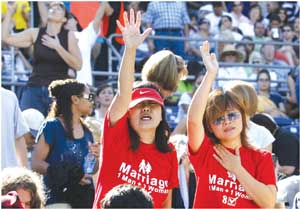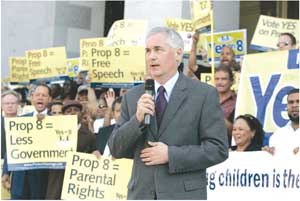feature
People of the Year: The Yes on 8 campaign
Published Thursday, 18-Dec-2008 in issue 1095
Nationwide, same-sex marriage sat center stage on Election Day.
With ballot initiatives writing a ban on same-sex marriage in Arizona, California and Florida’s state constitutions, millions of same-sex marriage supporters eyed the Golden State to set the course for a new civil rights movement.
What they were dealt, instead, was a gut-wrenching loss; a monumental step backward the same day the majority of the nation’s voters elected their first black president.
With more than $36 million and thousands of volunteers on hand, the Yes on 8 campaign – the campaign backing Proposition 8, California’s constitutional amendment banning same-sex marriage – launched a stunning comeback from early polls, which showed Proposition 8 trailing in the double digits.
The No on 8 campaign – the campaign organized to defeat Proposition 8 – fell short; and the Yes on 8 campaign reignited a community’s sense of social justice.
“[The No on 8 campaign] had everything in the world going for them this year, and they couldn’t win,” Frank Schubert, co-manager of the Yes on 8 campaign in California told the Associated Press last month. “I don’t think they’re going to be any more successful in 2010 or 2012.”
Final election results show that 599,602 more California voters cast ballots in favor of Proposition 8 than voted to keep same-sex marriage legal.
With the Yes campaign’s high profile win and the widespread ramifications – some, perhaps, not yet realized – of the marriage ban in California, the Gay & Lesbian Times would be remiss to not recognize the Yes on 8 campaign as being the most influential newsmaker and having the most impact on our community in 2008. The official tally certified Saturday by Secretary of State Debra Bowen shows Proposition 8 passing 52.3 percent to 47.7 percent.
The final numbers indicate that Proposition 8 passed in 43 of the state’s 58 counties, including Los Angeles County, a critical battleground.
With the Yes campaign’s high profile win and the widespread ramifications – some, perhaps, not yet realized – of the marriage ban in California, the Gay & Lesbian Times would be remiss to not recognize the Yes on 8 campaign as being the most influential newsmaker and having the most impact on our community in 2008.
For this reason, we’ve named the folks behind the Yes on 8 campaign our People of the Year. Certainly it’s no honor or award, and not intended to commend the campaign or its leaders for their work, or the tactics used in achieving victory.
However, Proposition 8 and the Yes on 8 campaign have defined marriage in the state constitution as a union between a man and a woman. The Yes campaign’s supporters have made our fight for equal marriage rights more difficult and costly. The win in California has energized opponents of same-sex marriage nationwide. And – perhaps most importantly, and the greatest reason the Yes campaign should be recognized – it’s galvanized the gay, lesbian, bisexual and transgender community to organize at a grassroots level and advocate for full, fundamental rights, not only at the state level, but federally as well.
“As shocking, as gut wrenching, as painful as this loss had been, it’s really galvanized an enormous amount of people, particularly people not previously involved,” said Delores Jacobs, executive director of The San Diego LGBT Community Center and a member of the No on 8 executive committee. “The loss here stuns the nation, and it’s really gotten an enormous number of people involved. It’s focused people on a federal level – and not just on marriage equality, really more on equal rights for issues for LGBT Americans, and what it will take to win equality.”
While you’d be hard-pressed to find a same-sex marriage supporter who praises the tactics of the Yes on 8 campaign, critics of the No campaign are in no short supply.
Robin Tyler, who, along with Diane Olson, was one of the original plaintiffs in the marriage cases before the California Supreme Court, has been a vocal critic of the No on 8 campaign’s failed effort at convincing California’s voters to reject the ban.
The campaign shouldn’t have been run from community service centers, she says, and campaign organizers were ill-prepared to manage the magnitude of the task; they didn’t utilize a strong grassroots effort, and rejected the advice of those whose help may have made a difference, she says.
She’s also disappointed the No campaign didn’t define the battle over the measure first. Instead, the Yes campaign launched an effective grassroots blitz to quickly label the high court’s ruling as “judicial activism,” and convince voters the Supreme Court rejected the will of the people. From there, the Yes campaign’s tactics became more aggressive, relying on tried and true rhetoric: faith, fear and falsehoods.
“Yes on 8 ran a strong, aggressive campaign,” Tyler said. “They came out with a sledgehammer and we hit them with a slingshot. They came in like sharks, they didn’t tell the truth, they hid behind their Christian children and they hid the fact they are bigots. They launched a campaign built totally on lies. They used the same scare tactics they’ve always used. [Proposition 8] was about discrimination.”
“Everyone told me it could not be done, people do not care about this enough, you will be overwhelmed and you will lose,” Maggie Gallagher, executive director of the National Organization for Marriage, told the Associated Press in November. Gallagher’s group provided seed money early this year to qualify Proposition 8 for the ballot. “This is an issue people care about when they understand what is at stake and we mount a vigorous and visible defense of marriage,”
According to published reports, the Yes campaign has attributed its victory to a number of factors.
Among them:
• The support of The Church of Jesus Christ of Latter-day Saints, which was critical in mobilizing volunteers and early campaign dollars; its support is considered a “difference maker” in the campaign’s ability to saturate media markets early in the fight, and reach more undecided voters with the sheer number of volunteers generated.
• A disciplined approach to targeting ethnic communities by targeting ethnic communities of faith; the Yes campaign anticipated a large number of ethnic voters, who are typically more influenced by their faith communities. They developed relationships with community organizers to drive home a message of “traditional marriage” – going so far as to mislead voters to believes Barack Obama supported Proposition 8.
• Early organization; they organized early – some say as early as November 2007 – creating a structure and the foundation for a high-profile campaign in the Golden State. They recruited leaders from national organizations to lay the groundwork for an epic fight in California, where they anticipated the Supreme Court’s ruling.
• Utilizing a powerful organizational tool from the get-go: churches. Each week, churches throughout California became recruiting grounds for volunteers, and airways for the Yes campaign’s message. Week after week, thousands of voters in congregations statewide were exposed to the Yes campaign’s themes and pleas for support. Churches provided a powerful infrastructure, and became one of the campaign’s greatest tools in achieving victory.
• The argument children will be taught about same-sex marriage in schools; the campaign gained quite a bit of traction with its argument parents would have no control over what their children would be taught in schools. Similarly, the campaign claimed churches would be at risk for losing tax-exempt status for refusing to perform same-sex weddings. The fear tactics were similar to what campaigns used in the past – and, just as effective today as they were before.
Tyler says some of the tactics used by the Yes campaign should have been anticipated by the No side – after all, they were similar to the arguments used by supporters of Proposition 6 in 1978, which would have banned gays and lesbians from teaching in California’s public schools, she says.
The silver lining, she says: what some perceived as the No campaign’s attempt to keep gay and lesbian couples off of the airwaves didn’t prove to be successful. Also, Tyler says, if Proposition 8 hadn’t passed, fewer people would now be engaged in the fight for civil rights.
“Had we won, the organizers of the No on 8 campaign would have been right,” Tyler said. “They would have been proven right – that if we’re quiet, if we’re invisible, if we go away, they can win this fight for us. Had we not lost, we wouldn’t have had hundreds of thousands of people pouring into the streets. We wouldn’t have had youth realize, ‘Forget marriage rights – no, this is about civil rights in the United States.’ This is a civil rights movement.”
Jacobs agrees with Tylers’ last point – that more people, gay and straight, are engaged in this issue as a result of Proposition 8’s passage. And – if nothing else can be credited to the Yes on 8 campaign – the mobilization and the sense of social responsibility the loss of marriage rights in California has inspired brings hope for the future.
“It’s engaged not just a new generation, but new people straight and gay, on the issue of equality; that this is a fundamental issue. … It’s awakened communities of faith – ‘Wait, maybe I don’t agree with the most conservative faith leadership anymore; maybe I don’t have to.’ It’s awakened them to think maybe the business of faith is not to restrict equal rights, but promote social justice. Social justice is an important issue, and it isn’t just our issue,” Jacobs said. “So, as gut-wrenching as this loss is, those outcomes sure make us hopeful for the future.”
|
|
Copyright © 2003-2025 Uptown Publications





